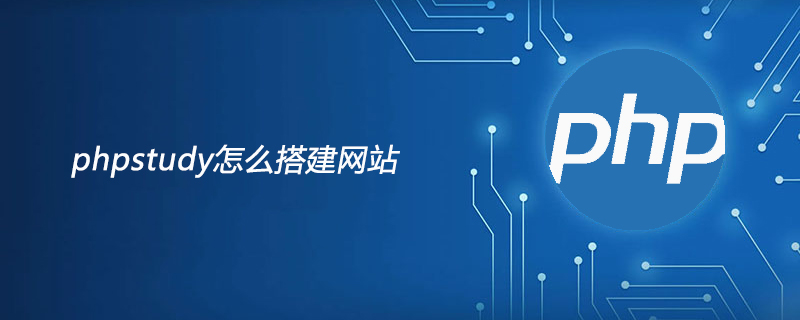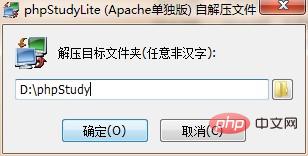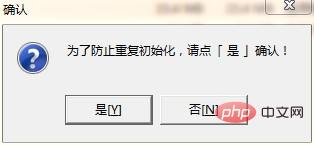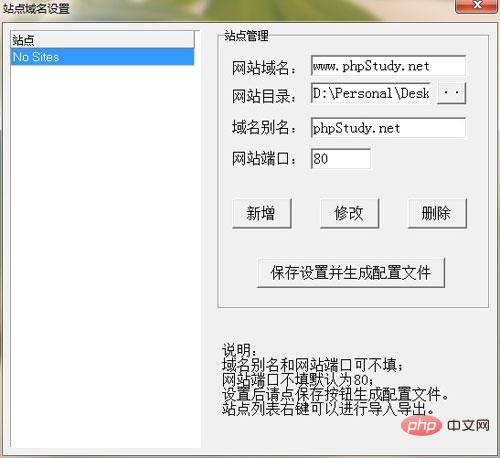How to build a website in phpstudy

Many novice users who have just started learning PHP must have been exposed to integrated environments. Among the many integrated environments, PHPstudy is very good. It is a simple tool developed by a domestic team. The easy-to-use PHP integrated environment has accumulated a large number of users because of its simplicity of setting up a PHP environment with one-click installation.
Now PHPstudy not only supports the local PHP integrated environment, but also supports the win server side Server integrated environment, PHPstudy integrates various combinations such as php mysql apache nginx iis, etc. We can better switch its php integrated environment. Let's teach you how to use PHPstudy to build a local website.
First, Download PHPstudy
Go directly to the official website of PHPstudy to download. The official website address is http://www.phpstudy.net/. The latest version of phpstudy is currently It is PHPstudy2018. You can download the latest version. Of course, your system must keep up.
Second, Install PHPstudy
After downloading PHPstudy, just double-click and install it. The steps are as follows:
(1), Double-click to display the following interface.

If you need to change the directory, just change it here.
(2), here we choose the default, click OK, as follows:

(3), click "Yes (Y)" directly, and it will appear The following interface.
 、
、
Okay, PHPstudy has been installed at this time. You will understand the use of PHPstudy after playing with it for two days. There is nothing to say.
Three, Build a local site
After the installation is completed, the source code folder is WWW, place your source code in this folder
Four, Configuring PHPstudy
After we copy the site files, we need to configure PHPstudy so that it points to our local website, open PHPstudy, select other selection menus, and enter site domain name management ( This step can be ignored. The default access is: 127.0.0.1) as shown below:

is mainly the website directory. Be sure to select the site directory we just created. Everything else is Don't worry, click "Save settings and generate configuration file".
Fifth, Configuring the hosts file
Because the default domain name above is www.phpStudy.net, so here we also need to configure the hosts file, point it, and open it PHPstudy, select the other options menu, open hosts, edit or add the following code:
#localhost
127.0.0.1 localhost
127.0.0.1 phpStudy.net
127.0.0.1 www.phpStudy.net
Six, Install the php website source code
At this time, we can directly open www.phpStudy.net to install wordpress. The installation is very simple and will not be introduced here. If the source code we use is not WordPress, we also need to import the database. At this time, we need to use mysql database and other related tools. However, most of the excellent PHP source codes on the Internet are directly installed and imported. of.
Recommended tutorial: phpStudy quick entry video tutorial
The above is the detailed content of How to build a website in phpstudy. For more information, please follow other related articles on the PHP Chinese website!

Hot AI Tools

Undresser.AI Undress
AI-powered app for creating realistic nude photos

AI Clothes Remover
Online AI tool for removing clothes from photos.

Undress AI Tool
Undress images for free

Clothoff.io
AI clothes remover

Video Face Swap
Swap faces in any video effortlessly with our completely free AI face swap tool!

Hot Article

Hot Tools

Notepad++7.3.1
Easy-to-use and free code editor

SublimeText3 Chinese version
Chinese version, very easy to use

Zend Studio 13.0.1
Powerful PHP integrated development environment

Dreamweaver CS6
Visual web development tools

SublimeText3 Mac version
God-level code editing software (SublimeText3)

Hot Topics
 PHP 8.4 Installation and Upgrade guide for Ubuntu and Debian
Dec 24, 2024 pm 04:42 PM
PHP 8.4 Installation and Upgrade guide for Ubuntu and Debian
Dec 24, 2024 pm 04:42 PM
PHP 8.4 brings several new features, security improvements, and performance improvements with healthy amounts of feature deprecations and removals. This guide explains how to install PHP 8.4 or upgrade to PHP 8.4 on Ubuntu, Debian, or their derivati
 How To Set Up Visual Studio Code (VS Code) for PHP Development
Dec 20, 2024 am 11:31 AM
How To Set Up Visual Studio Code (VS Code) for PHP Development
Dec 20, 2024 am 11:31 AM
Visual Studio Code, also known as VS Code, is a free source code editor — or integrated development environment (IDE) — available for all major operating systems. With a large collection of extensions for many programming languages, VS Code can be c
 Explain JSON Web Tokens (JWT) and their use case in PHP APIs.
Apr 05, 2025 am 12:04 AM
Explain JSON Web Tokens (JWT) and their use case in PHP APIs.
Apr 05, 2025 am 12:04 AM
JWT is an open standard based on JSON, used to securely transmit information between parties, mainly for identity authentication and information exchange. 1. JWT consists of three parts: Header, Payload and Signature. 2. The working principle of JWT includes three steps: generating JWT, verifying JWT and parsing Payload. 3. When using JWT for authentication in PHP, JWT can be generated and verified, and user role and permission information can be included in advanced usage. 4. Common errors include signature verification failure, token expiration, and payload oversized. Debugging skills include using debugging tools and logging. 5. Performance optimization and best practices include using appropriate signature algorithms, setting validity periods reasonably,
 PHP Program to Count Vowels in a String
Feb 07, 2025 pm 12:12 PM
PHP Program to Count Vowels in a String
Feb 07, 2025 pm 12:12 PM
A string is a sequence of characters, including letters, numbers, and symbols. This tutorial will learn how to calculate the number of vowels in a given string in PHP using different methods. The vowels in English are a, e, i, o, u, and they can be uppercase or lowercase. What is a vowel? Vowels are alphabetic characters that represent a specific pronunciation. There are five vowels in English, including uppercase and lowercase: a, e, i, o, u Example 1 Input: String = "Tutorialspoint" Output: 6 explain The vowels in the string "Tutorialspoint" are u, o, i, a, o, i. There are 6 yuan in total
 Explain late static binding in PHP (static::).
Apr 03, 2025 am 12:04 AM
Explain late static binding in PHP (static::).
Apr 03, 2025 am 12:04 AM
Static binding (static::) implements late static binding (LSB) in PHP, allowing calling classes to be referenced in static contexts rather than defining classes. 1) The parsing process is performed at runtime, 2) Look up the call class in the inheritance relationship, 3) It may bring performance overhead.
 How do you parse and process HTML/XML in PHP?
Feb 07, 2025 am 11:57 AM
How do you parse and process HTML/XML in PHP?
Feb 07, 2025 am 11:57 AM
This tutorial demonstrates how to efficiently process XML documents using PHP. XML (eXtensible Markup Language) is a versatile text-based markup language designed for both human readability and machine parsing. It's commonly used for data storage an
 What are PHP magic methods (__construct, __destruct, __call, __get, __set, etc.) and provide use cases?
Apr 03, 2025 am 12:03 AM
What are PHP magic methods (__construct, __destruct, __call, __get, __set, etc.) and provide use cases?
Apr 03, 2025 am 12:03 AM
What are the magic methods of PHP? PHP's magic methods include: 1.\_\_construct, used to initialize objects; 2.\_\_destruct, used to clean up resources; 3.\_\_call, handle non-existent method calls; 4.\_\_get, implement dynamic attribute access; 5.\_\_set, implement dynamic attribute settings. These methods are automatically called in certain situations, improving code flexibility and efficiency.
 PHP and Python: Comparing Two Popular Programming Languages
Apr 14, 2025 am 12:13 AM
PHP and Python: Comparing Two Popular Programming Languages
Apr 14, 2025 am 12:13 AM
PHP and Python each have their own advantages, and choose according to project requirements. 1.PHP is suitable for web development, especially for rapid development and maintenance of websites. 2. Python is suitable for data science, machine learning and artificial intelligence, with concise syntax and suitable for beginners.






